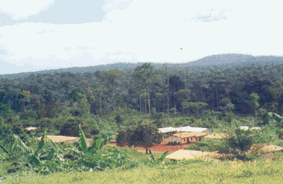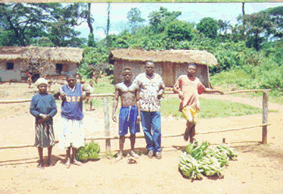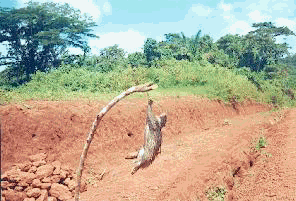

0807-B4
Virpi Lahtela and Cléto Ndikumagenge 1
Donors, scientists, administrative staff and rural populations living close to protected areas and forest concessions often have very differing ideas on the management of the forest area (protected areas and forest concessions).
Donors are convinced that, thanks to conditions linked to the granting of funds, they will be able to force governments to carry out institutional reforms that will significantly reduce the pressure on the forest resources put on by the rural populations.
Researchers think nothing concrete can be done without research on the effective involvement of the population.
Representatives of the administration think that they have done a lot by revising instruments that enable it to relinquish most of its prerogatives to non-governmental organizations and the population.
Meanwhile, the local populations feel left out of the discussion because they were never involved in it or other related activities.
Yet, all four interlocutors realize that lack of dialogue and communication are the basis of misunderstandings and they are willing to change to new strategies in order to better manage forest areas. These strategies are mostly based on communication between decision-makers and the populations, change of approach in appraising issues, and the promotion of a bottom-up vision.

Photo: C. NDIKUMAGENGE
The story takes place in a rural central African market around a forest area. A donor Agency functionary, Mr Young, visits during his work mission a forest known as a world heritage to evaluate the effects of reforms driven by funding bodies within the framework of protected area management. A country researcher, Maïdou, and a representative of the forestry administration, Mr Abega, accompany him. In the field they start to talk about the conservation of this forest and the implementation of the forestry law that was recently enacted and ratified by the National Assembly. After some minutes of discussions, a village woman, Mrs Kede who is on her way to the market to sell non-timber forest products harvested from the forest, joins their talk by a chance. An interesting discussion arises:
Young:
The purpose of my mission is to visit the accomplishments of our project and the effects of our policies on forest management. We requested that countries receiving our funds carry out institutional reforms on natural resource management. From a political point of view, these reforms should go alongside with democratisation and their direct consequences on forests: decentralise participation of local communities in the resource management, private sector participation for sound sustainable management of resources.

Photo C. NDIKUMAGENGE
We also requested that policies be harmonised at sub-regional level through consultation and exchange fora such as the Central African Heads of State Summit on the Conservation and Sustainable Management of Tropical Forests (CEFDHAC), and the Permanent Inter-States Committee to combat Desertification in the Sahel (CILSS), in order to facilitate the implementation of these policies.
Abega:
Mr Young, I'm sorry to tell you that your approach had very little impact in the field. As you can see for yourself, poaching and pressure on the forest by local populations are instead increasing. Because of your conditions, you pushed us into undertaking hasty reforms with international consultants imposed on us by you to draft the new texts. After the Tropical Forest Action Plan (TFAP), you asked us to prepare National Environmental Management Programmes (NEMP) and now you are asking us to start with Forest-Environment Sectoral Programmes. The forestry code has just been revised and even ratified by the National Assembly. Ten years ago, we even created a ministry in charge of the environment, but I have the feeling that all of these have had no change in the management of our forest areas.
Maïdou:
All what you are saying is useless if a research that will give a clear idea on how to enhance forest areas by preserving forest resources through the promotion of non-timber forest products is not accompanied. To give an example, organisations such as the IUCN -the World Conservation Union- has undertaken important research on enhancing non-timber forest products in various countries of Africa, Asia and Latin America. Meanwhile, nothing is done in terms of research in our region.
In our country the legislation on forest resources is inadequate and poorly adapted to the scientific research context and there is clearly a lack of harmony in the planning of research programmes.
Mrs Kede:
All what you are talking about do not concern us, for research findings never reach us, donor funding ends at the level of the administration, and administrative reforms are never translated into national languages for us to understand their content. For what comes to the valorisation of the non-timber forest products, no improvement is perceptible. We are still extracting moabi (Baillonella toxisperma) or karité (Vitellaria paradoxa) oil in the same ways as our grandparents have always been doing. Furthermore, our husbands are still selling bushmeat in the capital since it is one of the main sources of revenue for our families.

Photo: C. NDIKUMAGENGE
Young:
I have realised that the impact of international conventions, such as the Convention on Biological Diversity (CBD) and the Convention on International Trade of Endangered Species of wild fauna and flora (CITES), is very low since you are not yet aware of these conventions. This is surprising to me, since we have allocated a lot of money for the decision-makers and the local population to explain the challenges and impacts of these international conventions in order to better protect wild fauna in their forests.
Maïdou:
Researchers do not know about the conventions you are talking about. I have never taken part in a seminar on these conventions and I have never had copies of these texts; whereas I am in charge of carrying out accompanying research for greater involvement of local populations in the natural resources management. No research is in view to analyse the feasibility of implementing these conventions.
Abega:
We have a lot of difficulties implementing the international conventions, for the texts are "kept" by the focal points of these conventions. In addition, the other civil servants of the administration do not use them.
Further, no co-ordination mechanism enables the involvement of other ministries or stakeholders (NGOs, civil societies, local population, etc.) in the implementation process.
Mrs Kede:
In fact, we need these conventions to know more about animal and plant species that are protected and those that are endangered.
We also need true partnership between the populations, the administration, and even donors to analyse together how each and everyone can contribute in managing our forests.
Also, we have seen that for us, the rural populations, no funding mechanism for enabling to find alternatives for the use of bushmeat and other non-timber forest products is being implemented.
Young:
It should be understood that the whole problem of funding in general, and that of protected areas and forests in particular, evolve with time. Currently, donors no longer want to have " the assisted" who "receive aid", but would rather like to have partners in the countries that receive these funds. That is why we are encouraging and supporting appropriate funding frameworks such as the New Partnership for African Development (NEPAD). We are also encouraging new innovative funding mechanisms within the framework of carbon sinks and the use of funds generated by forests for conservation and development.
For forest concessions, donors now encourage the transformation of funds derived from taxes paid by logging companies into development and conservation funds.
Maïdou:
The problem of the lack of funds for research is very serious because the countries no longer allocate money for this. Furthermore, in our region we have no research on non-timber forest products whereas it is of great economic importance to the population.
To take an example from Burkina Faso, shea butter, or karite, is estimated to have a total transaction between suppliers and buyers of about 6.1 million USD in 2002 (L'Observateur, 2002). Similarly, in Senegal a study by IUCN on the economic value of wild resources estimated the total value added from the harvest of non-timber, non-fuel forest products at between 5.3 to 17 million USD (UDRSS/VALEURS, 2002). There is a true potential for poverty reduction by the help of these products. We only need more knowledge about the varieties of the plants and some support in better processing and marketing methods in order to compete in the markets.
The lack of a regional vision and the collaboration between research institutions in the sub-region do not make it possible for information on non-timber forest products and experiences of participatory management to circulate. To give an example, there is no reliable statistics on non-timber forest products in our region.
We do not have the appropriate framework to circulate research findings on protected areas in the region neither. We have to make an effort to open up towards the population, the administration and even to donors.

Photo: C. NDIKUMAGENGE
Abega:
I accept that there is a lack of co-ordination in our forestry administrations and that there is no institutional framework that would enable co-ordination of multiple interventions in and around the forest. We have to revise the method of designing projects and we have to co-ordinate the interventions of donors. The local population should be more involved than before since the reforms that we have undertaken on paper have not yet reached the target populations.
The lack of dialogue and communication is the main obstacle to the success of our programmes.
Young:
The entire fund granting system has to be revised because I have realised that very little money ends up to the local population. Real reforms should take into consideration the needs of the local inhabitants. We shall act on the request of the population.
Mrs Kede:
That's it Mr Young. You have understood the real problem. We are prepared to implement national laws and international conventions on the preservation of forests and protected areas on condition that we are informed about them. We are interested in co-management programmes for natural resources. Funding mechanisms should take our needs into consideration and not only those of ministries and researchers.
Each project should be implemented in the field and no longer left on paper.
Active communication and dialogue between the different actors would help us to understand each other better and to conserve our resources more efficiently.
The paper proves that the population, researchers, donors and the administration do not conceive the problems of forest management (protected areas and forest concessions) in the same way by the. It can be concluded that there is a lack of dialogue between actors and reforms imposed by donors, which should effectively implicate all stakeholders.
It was manifested that in the institutional review process and the implementation of international conventions, researchers are often not implicated despite the fact that their contributions are indispensable. The population is not even aware of the stakes and impact linked to these conventions.
The policies adopted by these countries in the management of wildmeat do not suggest any alternative source of protein for the local population, in order to reduce the pressure on wildmeat. Also, threatened species on the IUCN Red lists are not known by actors who are supposed to implement it.
Partnership between donors on one side and actors on the other side, are ways to ensure better conservation of natural forest resources.
Finally, the conservation and management of forest areas should not be seen from the point of view of a single country. The dynamism of a regional vision initiated in Central and West Africa has to be encouraged and supported more broadly.
Koyo, 1999. Bases pour la mise en cohérence des politiques et lois forestières des Pays d'Afrique Centrale. CEFDHAC, IUCN. 66pp.
L'Observateur (2002). Filiere Karite - Vers la conquête du marché mondial. No 5744, pg. 5, 3rd Octobre 2002.
République du Sénégal, 2002. Le NEPAD expliqué. In Rapport de la réunion préparatoire au sommet mondial du Développement durable.
RIEDACKER A., NDIKUMAGENGE C., HAKIZUMWAMI E. et al, 2002. Echanges d'informations sur les textes internationaux concernant les ressources forestières. Projet UE/SILVA/FAO.
UDRSS/VALEURS (2002). Project "Utilisation Durable des Ressources Sauvages". Rapport de fin de phase 1. UICN Mission au Sénégal, Août 2002.
1 Forest Officer. Bureau Régional de l'UICN pour l'Afrique de l'Ouest. 01 B.P 1618 Ouagadougou, Burkina Faso. virpi.lahtela@ iucn.org